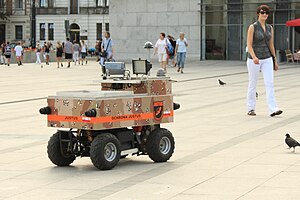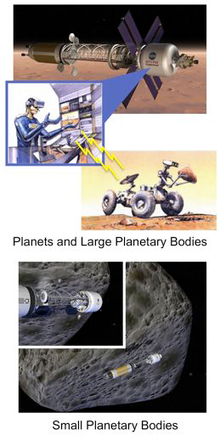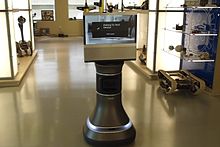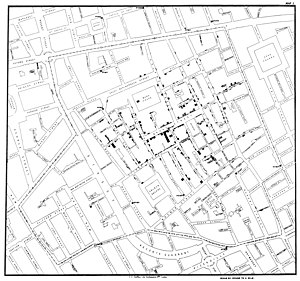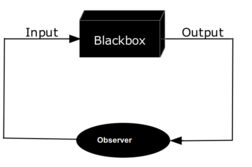From Wikipedia, the free encyclopedia
Even very young children perform rudimentary experiments to learn about the world and how things work.
An
experiment is a procedure carried out to support, refute, or validate a
hypothesis.
Experiments vary greatly in goal and scale, but always rely on
repeatable procedure and logical analysis of the results. There also
exists
natural experimental studies.
A child may carry out basic experiments to understand gravity,
while teams of scientists may take years of systematic investigation to
advance their understanding of a phenomenon. Experiments and other types
of hands-on activities are very important to student learning in the
science classroom. Experiments can raise test scores and help a student
become more engaged and interested in the material they are learning,
especially when used over time.
Experiments can vary from personal and informal natural comparisons
(e.g. tasting a range of chocolates to find a favorite), to highly
controlled (e.g. tests requiring complex apparatus overseen by many
scientists that hope to discover information about subatomic particles).
Uses of experiments vary considerably between the
natural and
human sciences.
Experiments typically include
controls, which are designed to minimize the effects of variables other than the single
independent variable. This increases the reliability of the results, often through a comparison between control
measurements and the other measurements. Scientific controls are a part of the
scientific method.
Ideally, all variables in an experiment are controlled (accounted for
by the control measurements) and none are uncontrolled. In such an
experiment, if all controls work as expected, it is possible to conclude
that the experiment works as intended, and that results are due to the
effect of the tested variable.
Overview
An experiment usually tests a
hypothesis,
which is an expectation about how a particular process or phenomenon
works. However, an experiment may also aim to answer a "what-if"
question, without a specific expectation about what the experiment
reveals, or to confirm prior results. If an experiment is carefully
conducted, the results usually either support or disprove the
hypothesis. According to some
philosophies of science, an experiment can never "prove" a hypothesis, it can only add support. On the other hand, an experiment that provides a
counterexample can disprove a theory or hypothesis, but a theory can always be salvaged by appropriate
ad hoc modifications at the expense of simplicity. An experiment must also control the possible
confounding factors—any
factors that would mar the accuracy or repeatability of the experiment
or the ability to interpret the results. Confounding is commonly
eliminated through
scientific controls and/or, in
randomized experiments, through
random assignment.
In
engineering
and the physical sciences, experiments are a primary component of the
scientific method. They are used to test theories and hypotheses about
how physical processes work under particular conditions (e.g., whether a
particular engineering process can produce a desired chemical
compound). Typically, experiments in these fields focus on
replication of identical procedures in hopes of producing identical results in each replication. Random assignment is uncommon.
In medicine and the
social sciences,
the prevalence of experimental research varies widely across
disciplines. When used, however, experiments typically follow the form
of the
clinical trial,
where experimental units (usually individual human beings) are randomly
assigned to a treatment or control condition where one or more outcomes
are assessed. In contrast to norms in the physical sciences, the focus is typically on the
average treatment effect (the difference in outcomes between the treatment and control groups) or another
test statistic produced by the experiment. A single study typically does not involve replications of the experiment, but separate studies may be aggregated through
systematic review and
meta-analysis.
There are various differences in experimental practice in each of the
branches of science. For example,
agricultural research frequently uses randomized experiments (e.g., to test the comparative effectiveness of different fertilizers), while
experimental economics
often involves experimental tests of theorized human behaviors without
relying on random assignment of individuals to treatment and control
conditions.
History
One of the first methodical approaches to experiments in the modern
sense is visible in the works of the Arab mathematician and scholar
Ibn al-Haytham. He conducted his experiments in the field of optics - going back to optical and mathematical problems in the works of
Ptolemy
- by controlling his experiments due to factors such as
self-criticality, reliance on visible results of the experiments as well
as a criticality in terms of earlier results. He counts as one of the
first scholars using an inductive-experimental method for achieving
results. In his book "Optics" he describes the fundamentally new approach to knowledge and research in an experimental sense:
"We should, that is, recommence the inquiry into its
principles and premisses, beginning our investigation with an inspection
of the things that exist and a survey of the conditions of visible
objects. We should distinguish the properties of particulars, and gather
by induction what pertains to the eye when vision takes place and what
is found in the manner of sensation to be uniform, unchanging, manifest
and not subject to doubt. After which we should ascend in our inquiry
and reasonings, gradually and orderly, criticizing premisses and
exercising caution in regard to conclusions – our aim in all that we
make subject to inspection and review being to employ justice, not to
follow prejudice, and to take care in all that we judge and criticize
that we seek the truth and not to be swayed by opinion. We may in this
way eventually come to the truth that gratifies the heart and gradually
and carefully reach the end at which certainty appears; while through
criticism and caution we may seize the truth that dispels disagreement
and resolves doubtful matters. For all that, we are not free from that
human turbidity which is in the nature of man; but we must do our best
with what we possess of human power. From God we derive support in all
things."
According to his explanation, a strictly controlled test
execution with a sensibility for the subjectivity and susceptibility of
outcomes due to the nature of man is necessary. Furthermore, a critical
view on the results and outcomes of earlier scholars is necessary:
"It is thus the duty of the man
who studies the writings of scientists, if learning the truth is his
goal, to make himself an enemy of all that he reads, and, applying his
mind to the core and margins of its content, attack it from every side.
He should also suspect himself as he performs his critical examination
of it, so that he may avoid falling into either prejudice or leniency."
Thus, a comparison of earlier results with the experimental results
is necessary for an objective experiment - the visible results being
more important. In the end, this may mean that an experimental
researcher must find enough courage to discard traditional opinions or
results, especially if these results are not experimental but results
from a logical/ mental derivation. In this process of critical
consideration, the man himself should not forget that he tends to
subjective opinions - through "prejudices" and "leniency" - and thus has
to be critical about his own way of building hypotheses.
Francis Bacon (1561–1626), an English
philosopher and
scientist active in the 17th century, became an influential supporter of experimental science in the
English renaissance. He disagreed with the method of answering scientific questions by
deduction - similar to
Ibn al-Haytham
- and described it as follows: "Having first determined the question
according to his will, man then resorts to experience, and bending her
to conformity with his placets, leads her about like a captive in a
procession."
Bacon wanted a method that relied on repeatable observations, or
experiments. Notably, he first ordered the scientific method as we
understand it today.
There
remains simple experience; which, if taken as it comes, is called
accident, if sought for, experiment. The true method of experience first
lights the candle [hypothesis], and then by means of the candle shows
the way [arranges and delimits the experiment]; commencing as it does
with experience duly ordered and digested, not bungling or erratic, and
from it deducing axioms [theories], and from established axioms again
new experiments.
In the centuries that followed, people who applied the scientific
method in different areas made important advances and discoveries. For
example,
Galileo Galilei
(1564-1642) accurately measured time and experimented to make accurate
measurements and conclusions about the speed of a falling body.
Antoine Lavoisier (1743-1794), a French chemist, used experiment to describe new areas, such as
combustion and
biochemistry and to develop the theory of
conservation of mass (matter).
Louis Pasteur (1822-1895) used the scientific method to disprove the prevailing theory of
spontaneous generation and to develop the
germ theory of disease. Because of the importance of controlling potentially confounding variables, the use of well-designed
laboratory experiments is preferred when possible.
Types of experiment
Experiments
might be categorized according to a number of dimensions, depending
upon professional norms and standards in different fields of study. In
some disciplines (e.g.,
psychology or
political science), a 'true experiment' is a method of social research in which there are two kinds of
variables. The
independent variable is manipulated by the experimenter, and the
dependent variable is measured. The signifying characteristic of a true experiment is that it
randomly allocates
the subjects to neutralize experimenter bias, and ensures, over a large
number of iterations of the experiment, that it controls for all
confounding factors.
Controlled experiments
A controlled experiment often compares the results obtained from experimental samples against
control
samples, which are practically identical to the experimental sample
except for the one aspect whose effect is being tested (the
independent variable). A good example would be a drug trial. The sample or group receiving the drug would be the experimental group (
treatment group); and the one receiving the
placebo or regular treatment would be the
control one. In many laboratory experiments it is good practice to have several
replicate samples for the test being performed and have both a
positive control and a
negative control.
The results from replicate samples can often be averaged, or if one of
the replicates is obviously inconsistent with the results from the other
samples, it can be discarded as being the result of an experimental
error (some step of the test procedure may have been mistakenly omitted
for that sample). Most often, tests are done in duplicate or triplicate.
A positive control is a procedure similar to the actual experimental
test but is known from previous experience to give a positive result. A
negative control is known to give a negative result. The positive
control confirms that the basic conditions of the experiment were able
to produce a positive result, even if none of the actual experimental
samples produce a positive result. The negative control demonstrates the
base-line result obtained when a test does not produce a measurable
positive result. Most often the value of the negative control is treated
as a "background" value to subtract from the test sample results.
Sometimes the positive control takes the quadrant of a
standard curve.
An example that is often used in teaching laboratories is a controlled
protein assay.
Students might be given a fluid sample containing an unknown (to the
student) amount of protein. It is their job to correctly perform a
controlled experiment in which they determine the concentration of
protein in the fluid sample (usually called the "unknown sample"). The
teaching lab would be equipped with a protein standard solution with a
known protein concentration. Students could make several positive
control samples containing various dilutions of the protein standard.
Negative control samples would contain all of the reagents for the
protein assay but no protein. In this example, all samples are performed
in duplicate. The assay is a
colorimetric assay in which a
spectrophotometer
can measure the amount of protein in samples by detecting a colored
complex formed by the interaction of protein molecules and molecules of
an added dye. In the illustration, the results for the diluted test
samples can be compared to the results of the standard curve (the blue
line in the illustration) to estimate the amount of protein in the
unknown sample.
Controlled experiments can be performed when it is difficult to
exactly control all the conditions in an experiment. In this case, the
experiment begins by creating two or more sample groups that are
probabilistically equivalent,
which means that measurements of traits should be similar among the
groups and that the groups should respond in the same manner if given
the same treatment. This equivalency is determined by
statistical methods that take into account the amount of variation between individuals and the
number of individuals in each group. In fields such as
microbiology and
chemistry,
where there is very little variation between individuals and the group
size is easily in the millions, these statistical methods are often
bypassed and simply splitting a
solution into equal parts is assumed to produce identical sample groups.
Once equivalent groups have been formed, the experimenter tries to treat them identically except for the one
variable that he or she wishes to isolate.
Human experimentation requires special safeguards against outside variables such as the
placebo effect. Such experiments are generally
double blind,
meaning that neither the volunteer nor the researcher knows which
individuals are in the control group or the experimental group until
after all of the data have been collected. This ensures that any effects
on the volunteer are due to the treatment itself and are not a response
to the knowledge that he is being treated.
In human experiments, researchers may give a
subject (person) a
stimulus that the subject responds to. The goal of the experiment is to
measure the response to the stimulus by a
test method.
Original map by John Snow showing the clusters of cholera cases in the London epidemic of 1854
In the
design of experiments, two or more "treatments" are applied to estimate the
difference between the mean
responses
for the treatments. For example, an experiment on baking bread could
estimate the difference in the responses associated with quantitative
variables, such as the ratio of water to flour, and with qualitative
variables, such as strains of yeast. Experimentation is the step in the
scientific method that helps people decide between two or more competing explanations – or
hypotheses.
These hypotheses suggest reasons to explain a phenomenon, or predict
the results of an action. An example might be the hypothesis that "if I
release this ball, it will fall to the floor": this suggestion can then
be tested by carrying out the experiment of letting go of the ball, and
observing the results. Formally, a hypothesis is compared against its
opposite or
null hypothesis
("if I release this ball, it will not fall to the floor"). The null
hypothesis is that there is no explanation or predictive power of the
phenomenon through the reasoning that is being investigated. Once
hypotheses are defined, an experiment can be carried out and the results
analysed to confirm, refute, or define the accuracy of the hypotheses.
Natural experiments
The term "experiment" usually implies a controlled experiment, but
sometimes controlled experiments are prohibitively difficult or
impossible. In this case researchers resort to
natural experiments or
quasi-experiments. Natural experiments rely solely on observations of the variables of the
system
under study, rather than manipulation of just one or a few variables as
occurs in controlled experiments. To the degree possible, they attempt
to collect data for the system in such a way that contribution from all
variables can be determined, and where the effects of variation in
certain variables remain approximately constant so that the effects of
other variables can be discerned. The degree to which this is possible
depends on the observed
correlation between
explanatory variables in the observed data. When these variables are
not
well correlated, natural experiments can approach the power of
controlled experiments. Usually, however, there is some correlation
between these variables, which reduces the reliability of natural
experiments relative to what could be concluded if a controlled
experiment were performed. Also, because natural experiments usually
take place in uncontrolled environments, variables from undetected
sources are neither measured nor held constant, and these may produce
illusory correlations in variables under study.
Much research in several
science disciplines, including
economics,
political science,
geology,
paleontology,
ecology,
meteorology, and
astronomy,
relies on quasi-experiments. For example, in astronomy it is clearly
impossible, when testing the hypothesis "Stars are collapsed clouds of
hydrogen", to start out with a giant cloud of hydrogen, and then perform
the experiment of waiting a few billion years for it to form a star.
However, by observing various clouds of hydrogen in various states of
collapse, and other implications of the hypothesis (for example, the
presence of various spectral emissions from the light of stars), we can
collect data we require to support the hypothesis. An early example of
this type of experiment was the first verification in the 17th century
that light does not travel from place to place instantaneously, but
instead has a measurable speed. Observation of the appearance of the
moons of Jupiter were slightly delayed when Jupiter was farther from
Earth, as opposed to when Jupiter was closer to Earth; and this
phenomenon was used to demonstrate that the difference in the time of
appearance of the moons was consistent with a measurable speed.
Field experiments
Field experiments are so named to distinguish them from
laboratory
experiments, which enforce scientific control by testing a hypothesis
in the artificial and highly controlled setting of a laboratory. Often
used in the social sciences, and especially in economic analyses of
education and health interventions, field experiments have the advantage
that outcomes are observed in a natural setting rather than in a
contrived laboratory environment. For this reason, field experiments are
sometimes seen as having higher
external validity
than laboratory experiments. However, like natural experiments, field
experiments suffer from the possibility of contamination: experimental
conditions can be controlled with more precision and certainty in the
lab. Yet some phenomena (e.g., voter turnout in an election) cannot be
easily studied in a laboratory.
Contrast with observational study
The black box model for observation (input and output are observables). When there are a feedback with some observer's control, as illustrated, the observation is also an experiment.
An
observational study
is used when it is impractical, unethical, cost-prohibitive (or
otherwise inefficient) to fit a physical or social system into a
laboratory setting, to completely control confounding factors, or to
apply random assignment. It can also be used when confounding factors
are either limited or known well enough to analyze the data in light of
them (though this may be rare when social phenomena are under
examination). For an observational science to be valid, the experimenter
must know and account for
confounding
factors. In these situations, observational studies have value because
they often suggest hypotheses that can be tested with randomized
experiments or by collecting fresh data.
Fundamentally, however, observational studies are not
experiments. By definition, observational studies lack the manipulation
required for
Baconian experiments.
In addition, observational studies (e.g., in biological or social
systems) often involve variables that are difficult to quantify or
control. Observational studies are limited because they lack the
statistical properties of randomized experiments. In a randomized
experiment, the method of randomization specified in the experimental
protocol guides the statistical analysis, which is usually specified
also by the experimental protocol. Without a statistical model that reflects an objective randomization, the statistical analysis relies on a subjective model. Inferences from subjective models are unreliable in theory and practice.
In fact, there are several cases where carefully conducted
observational studies consistently give wrong results, that is, where
the results of the observational studies are inconsistent and also
differ from the results of experiments. For example, epidemiological
studies of colon cancer consistently show beneficial correlations with
broccoli consumption, while experiments find no benefit.
A particular problem with observational studies involving human
subjects is the great difficulty attaining fair comparisons between
treatments (or exposures), because such studies are prone to
selection bias,
and groups receiving different treatments (exposures) may differ
greatly according to their covariates (age, height, weight, medications,
exercise, nutritional status, ethnicity, family medical history, etc.).
In contrast, randomization implies that for each covariate, the mean
for each group is expected to be the same. For any randomized trial,
some variation from the mean is expected, of course, but the
randomization ensures that the experimental groups have mean values that
are close, due to the
central limit theorem and
Markov's inequality.
With inadequate randomization or low sample size, the systematic
variation in covariates between the treatment groups (or exposure
groups) makes it difficult to separate the effect of the treatment
(exposure) from the effects of the other covariates, most of which have
not been measured. The mathematical models used to analyze such data
must consider each differing covariate (if measured), and results are
not meaningful if a covariate is neither randomized nor included in the
model.
To avoid conditions that render an experiment far less useful, physicians conducting medical trials – say for U.S.
Food and Drug Administration
approval – quantify and randomize the covariates that can be
identified. Researchers attempt to reduce the biases of observational
studies with complicated statistical methods such as
propensity score matching
methods, which require large populations of subjects and extensive
information on covariates. Outcomes are also quantified when possible
(bone density, the amount of some cell or substance in the blood,
physical strength or endurance, etc.) and not based on a subject's or a
professional observer's opinion. In this way, the design of an
observational study can render the results more objective and therefore,
more convincing.
Ethics
By placing the distribution of the independent variable(s) under the
control of the researcher, an experiment – particularly when it involves
human subjects
– introduces potential ethical considerations, such as balancing
benefit and harm, fairly distributing interventions (e.g., treatments
for a disease), and
informed consent.
For example, in psychology or health care, it is unethical to provide a
substandard treatment to patients. Therefore, ethical review boards are
supposed to stop clinical trials and other experiments unless a new
treatment is believed to offer benefits as good as current best
practice.
It is also generally unethical (and often illegal) to conduct
randomized experiments on the effects of substandard or harmful
treatments, such as the effects of ingesting arsenic on human health. To
understand the effects of such exposures, scientists sometimes use
observational studies to understand the effects of those factors.
Even when experimental research does not directly involve human
subjects, it may still present ethical concerns. For example, the
nuclear bomb experiments conducted by the
Manhattan Project
implied the use of nuclear reactions to harm human beings even though
the experiments did not directly involve any human subjects.
Experimental method in law
The experimental method can be useful in solving juridical problems.
